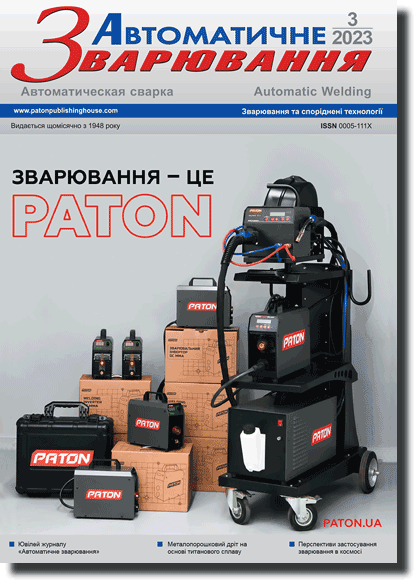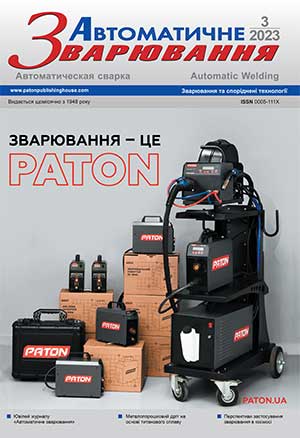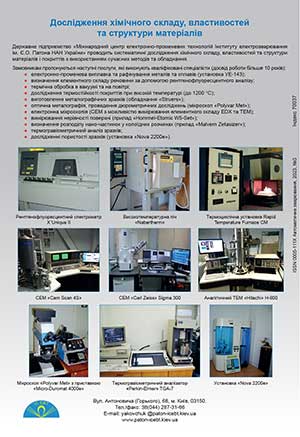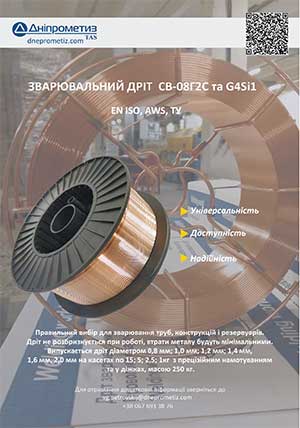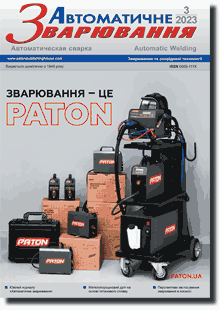
Avtomaticheskaya Svarka (Automatic Welding), #3, 2023, pp. 15-19
2E.O. Paton Electric Welding Institute of the NAS of Ukraine. 11 Kazymyr Malevych Str., 03150, Kyiv, Ukraine. E-mail: office@paton.kiev.ua
The paper presents the results of investigations on diffusion welding of high-temperature alloy EI437B, using foil from high-entropy alloy of CrMnFeCoNi system as an interlayer. The features of producing foil from high-entropy alloy and its main physical-chemical properties in as-rolled and as-annealed condition are given. Increase of the degree of the foil general deformation to 99.9 % results in up to three times increase of the yield limit, and further annealing of the foil leads to its lowering to values characteristic for EI437B alloy. During diffusion welding the Young’s modulus increased from 165 to 195 GPa in the joint zone corresponding to the high-entropy alloy, which may be indicative of a diffusion-induced redistribution of elements in the interlayer. Chemical element distribution in the joint zone is indicative of their sufficiently high diffusion mobility. It is shown that application of a high-entropy alloy interlayer in vacuum diffusion welding ensures formation of a diffusion zone of a rather homogeneous chemical composition with a monotonic nature of distribution of the main alloying elements. The thermodeformational impact results in equalizing of the characteristics of hardness and modulus of elasticity in different regions of the joint, and their physical-mechanical properties become similar. 15 Ref., 2 Tabl., 4 Fig.
Keywords: high-entropy alloy, nickel-based high-temperature alloy, vacuum diffusion welding, microstructure, hardness, modulus of elasticity, yield limit
Received: 22.03.2023
2. Egbewande, A.T., Buckson, R.A., Ojo, O.A. (2010) Analysis of laser beam weldability of Inconel 738 superalloy. Materials Characterization, 5, 61, 569-574. https://doi.org/10.1016/j.matchar.2010.02.016
3. Ojo, O.A., Richards, N.L., Chaturvedi, M.C. (2008) Heat affected zone liquation cracking in electron beam welded third generation nickel base superalloys. Materials Science and Engineering: A, 1-2, 476, 217-223. https://doi.org/10.1016/j.msea.2007.04.091
4. Rush, M.T., Colegrove, P.A., Zhang, Z. Courtot, B. (2010) An Investigation into Cracking in Nickel-Base Superalloy Repair Welds. Advanced Materials Research, 89-91, 467-472. https://doi.org/10.4028/www.scientific.net/AMR.89-91.467
5. Montazeri, M., Ghaini, F.M. (2012) The liquation cracking behavior of IN738LC superalloy during low power Nd:YAG pulsed laser welding. Materials Characterization, 67, 65-73. DOI: https:// doi.org/10.1016/j.matchar.2012.02.019 https://doi.org/10.1016/j.matchar.2012.02.019
6. Jiangtao Xiong, Lin Yuan, Yuan Zhub et al. (2019) Diffusion bonding of nickel-based superalloy GH4099 with pure nickel interlayer. Journal of Materials Science, 8, 54, 6552-6564. https://doi.org/10.1007/s10853-018-03274-x
7. Sung Hwan Kim, Chaewon Kim, Changheui Jang (2018) Diffusion Bonding of a Cold-Worked Ni-Base Superalloy. Proceedings of the ASME 2018 Symposium on Elevated Temperature Application of Materials for Fossil, Nuclear, and Petrochemical Industries ETAM2018 (Seattle, April 3-5), Seattle, WA, USA, 1-6. https://doi.org/10.1115/ETAM2018-6716
8. Petrushinets, L.V., Falchenko, Yu.V., Ustinov, A.I. et al. (2017) Vacuum diffusion welding of heat-resistant Ni-based alloy. Tekhnichni Nauky ta Tekhnologii, 3(9), 63-71 [in Ukrainian]. https://doi.org/10.25140/2411-5363-2017-3(9)-63-71
9. Falchenko, Iu.V., Petrushynets, L.V., Melnichenko, T.V. et al. (2019) Vacuum diffusion welding of γ-TiAl intermetallic with high-temperature nickel alloy with application of intermediate Al/Ni nanolayers. The Paton Welding Journal, 10, 48-53. https://doi.org/10.15407/tpwj2019.10.07
10. Yeh, J.W., Chen, L., Lin, S.J., Chen, S.K. (2007) High-Entropy Alloys - A New Era of Exploitation. Materials Science Forum, 560, 1-9. https://doi.org/10.4028/www.scientific.net/MSF.560.1
11. Murty, B.S., Yeh, J.W., Ranganathan, S. (2014) High Entropy Alloys. Butterworth-Heinemann. ISBN 978-0-12-800251-3. https://doi.org/10.1016/C2013-0-14235-3
12. Karpets', M.V., Myslyvchenko, O.M., Krapivka, M.O. et al. (2015) Influence of Plastic Deformation on the Phase Composition, Texture, and Mechanical Properties of the CrMnFeCoNi2Cu HighEntropy Alloy. Journal of Superhard Materials, 1, 37, 21-26. https://doi.org/10.3103/S1063457615010049
13. Podolskiy, A.V., Tabachnikova, E.D., Voloschuk, V.V. et al. (2018) Mechanical properties and thermally activated plasticity of the Ti30Zr25Hf15Nb20Ta10 high entropy alloy at temperatures 4.2-350 K. Materials Science and Engineering: A, 1, 710, 136-141. https://doi.org/10.1016/j.msea.2017.10.073
14. ISO UNE EN ISO 14577-1:2016 Metallic materials - Instrumented indentation test for hardness and materials parameters. Part 1: Test method (ISO 14577-1:2015).
15. Gorban, V.F., Pechkovskii, É.P. (2010) Instrumented indentation for determining the structural state of materials. Powder Metallurgy and Metal Ceramics, 49, 424-429. https://doi.org/10.1007/s11106-010-9253-1
Influence of high-entropy interlayer of CrMnFeCoNi system on micromechanical properties of joints of high-temperature alloy EI437B
Automatic Welding №03 2023 p.15-19
The cost of article: 150 UAH,16 $,15 €. (one article)
AS = «Automatic Welding» - 6 issues per year;
TPWJ = «PATON WELDING JOURNAL» - 12 issues per year;
SEM = «Electrometallurgy Today» - 4 issues per year;
TDNK = «Technical Diagnostics and Non-Destructive Testing» - 4 issues per year.
| 2023 №03 (02) |
DOI of Article 10.37434/as2023.03.03 |
2023 №03 (04) |

Avtomaticheskaya Svarka (Automatic Welding), #3, 2023, pp. 15-19
Influence of high-entropy interlayer of CrMnFeCoNi system on micromechanical properties of joints of high-temperature alloy EІ437B
V.F. Gorban’1, Iu.V. Falchenko2, L.V. Petrushinets2, T.V. Melnichenko2, M.O. Krapivka1, D.G. Verbilo1, V.A. Nazarenko1
1Institute for Problems of Materials Science of the NAS of Ukraine. 3 Krzhyzhanovskoho Str., 03142, Kyiv, Ukraine.2E.O. Paton Electric Welding Institute of the NAS of Ukraine. 11 Kazymyr Malevych Str., 03150, Kyiv, Ukraine. E-mail: office@paton.kiev.ua
The paper presents the results of investigations on diffusion welding of high-temperature alloy EI437B, using foil from high-entropy alloy of CrMnFeCoNi system as an interlayer. The features of producing foil from high-entropy alloy and its main physical-chemical properties in as-rolled and as-annealed condition are given. Increase of the degree of the foil general deformation to 99.9 % results in up to three times increase of the yield limit, and further annealing of the foil leads to its lowering to values characteristic for EI437B alloy. During diffusion welding the Young’s modulus increased from 165 to 195 GPa in the joint zone corresponding to the high-entropy alloy, which may be indicative of a diffusion-induced redistribution of elements in the interlayer. Chemical element distribution in the joint zone is indicative of their sufficiently high diffusion mobility. It is shown that application of a high-entropy alloy interlayer in vacuum diffusion welding ensures formation of a diffusion zone of a rather homogeneous chemical composition with a monotonic nature of distribution of the main alloying elements. The thermodeformational impact results in equalizing of the characteristics of hardness and modulus of elasticity in different regions of the joint, and their physical-mechanical properties become similar. 15 Ref., 2 Tabl., 4 Fig.
Keywords: high-entropy alloy, nickel-based high-temperature alloy, vacuum diffusion welding, microstructure, hardness, modulus of elasticity, yield limit
Received: 22.03.2023
References
1. Penkalla, H.J., Wosik, J., Czyrska-Filemonowicz, A. (2003) Quantitative microstructural characterisation of Ni-base superalloys. Materials Chemistry and Physics, 2-3, 81, 417- 423. https://doi.org/10.1016/S0254-0584(03)00037-32. Egbewande, A.T., Buckson, R.A., Ojo, O.A. (2010) Analysis of laser beam weldability of Inconel 738 superalloy. Materials Characterization, 5, 61, 569-574. https://doi.org/10.1016/j.matchar.2010.02.016
3. Ojo, O.A., Richards, N.L., Chaturvedi, M.C. (2008) Heat affected zone liquation cracking in electron beam welded third generation nickel base superalloys. Materials Science and Engineering: A, 1-2, 476, 217-223. https://doi.org/10.1016/j.msea.2007.04.091
4. Rush, M.T., Colegrove, P.A., Zhang, Z. Courtot, B. (2010) An Investigation into Cracking in Nickel-Base Superalloy Repair Welds. Advanced Materials Research, 89-91, 467-472. https://doi.org/10.4028/www.scientific.net/AMR.89-91.467
5. Montazeri, M., Ghaini, F.M. (2012) The liquation cracking behavior of IN738LC superalloy during low power Nd:YAG pulsed laser welding. Materials Characterization, 67, 65-73. DOI: https:// doi.org/10.1016/j.matchar.2012.02.019 https://doi.org/10.1016/j.matchar.2012.02.019
6. Jiangtao Xiong, Lin Yuan, Yuan Zhub et al. (2019) Diffusion bonding of nickel-based superalloy GH4099 with pure nickel interlayer. Journal of Materials Science, 8, 54, 6552-6564. https://doi.org/10.1007/s10853-018-03274-x
7. Sung Hwan Kim, Chaewon Kim, Changheui Jang (2018) Diffusion Bonding of a Cold-Worked Ni-Base Superalloy. Proceedings of the ASME 2018 Symposium on Elevated Temperature Application of Materials for Fossil, Nuclear, and Petrochemical Industries ETAM2018 (Seattle, April 3-5), Seattle, WA, USA, 1-6. https://doi.org/10.1115/ETAM2018-6716
8. Petrushinets, L.V., Falchenko, Yu.V., Ustinov, A.I. et al. (2017) Vacuum diffusion welding of heat-resistant Ni-based alloy. Tekhnichni Nauky ta Tekhnologii, 3(9), 63-71 [in Ukrainian]. https://doi.org/10.25140/2411-5363-2017-3(9)-63-71
9. Falchenko, Iu.V., Petrushynets, L.V., Melnichenko, T.V. et al. (2019) Vacuum diffusion welding of γ-TiAl intermetallic with high-temperature nickel alloy with application of intermediate Al/Ni nanolayers. The Paton Welding Journal, 10, 48-53. https://doi.org/10.15407/tpwj2019.10.07
10. Yeh, J.W., Chen, L., Lin, S.J., Chen, S.K. (2007) High-Entropy Alloys - A New Era of Exploitation. Materials Science Forum, 560, 1-9. https://doi.org/10.4028/www.scientific.net/MSF.560.1
11. Murty, B.S., Yeh, J.W., Ranganathan, S. (2014) High Entropy Alloys. Butterworth-Heinemann. ISBN 978-0-12-800251-3. https://doi.org/10.1016/C2013-0-14235-3
12. Karpets', M.V., Myslyvchenko, O.M., Krapivka, M.O. et al. (2015) Influence of Plastic Deformation on the Phase Composition, Texture, and Mechanical Properties of the CrMnFeCoNi2Cu HighEntropy Alloy. Journal of Superhard Materials, 1, 37, 21-26. https://doi.org/10.3103/S1063457615010049
13. Podolskiy, A.V., Tabachnikova, E.D., Voloschuk, V.V. et al. (2018) Mechanical properties and thermally activated plasticity of the Ti30Zr25Hf15Nb20Ta10 high entropy alloy at temperatures 4.2-350 K. Materials Science and Engineering: A, 1, 710, 136-141. https://doi.org/10.1016/j.msea.2017.10.073
14. ISO UNE EN ISO 14577-1:2016 Metallic materials - Instrumented indentation test for hardness and materials parameters. Part 1: Test method (ISO 14577-1:2015).
15. Gorban, V.F., Pechkovskii, É.P. (2010) Instrumented indentation for determining the structural state of materials. Powder Metallurgy and Metal Ceramics, 49, 424-429. https://doi.org/10.1007/s11106-010-9253-1
Advertising in this issue:
To order the electronic version of the paper:
V.F. Gorban’, Iu.V. Falchenko, L.V. Petrushinets, T.V. Melnichenko, M.O. Krapivka, D.G. Verbilo, V.A. NazarenkoInfluence of high-entropy interlayer of CrMnFeCoNi system on micromechanical properties of joints of high-temperature alloy EI437B
Automatic Welding №03 2023 p.15-19
The cost of article: 150 UAH,16 $,15 €. (one article)
fill in the form below:
The cost of subscription/purchase order journals or individual articles
| Journal/Currency | Annual Set | 1 issue printed |
1 issue |
one article |
| AS/UAH | 1800 UAH | 300 UAH | 300 UAH | 150 UAH |
| AS/USD | 192 $ | 32 $ | 26 $ | 16 $ |
| AS/EUR | 180 € | 30 € | 25 € | 15 € |
| TPWJ/UAH | 7200 UAH | 600 UAH | 600 UAH | 280 UAH |
| TPWJ/USD | 384 $ | 32 $ | 26 $ | 16 $ |
| TPWJ/EUR | 360 € | 30 € | 25 € | 15 € |
| SEM/UAH | 1200 UAH | 300 UAH | 300 UAH | 150 UAH |
| SEM/USD | 128 $ | 32 $ | 26 $ | 16 $ |
| SEM/EUR | 120 € | 30 € | 25 € | 15 € |
| TDNK/UAH | 1200 UAH | 300 UAH | 300 UAH | 150 UAH |
| TDNK/USD | 128 $ | 32 $ | 26 $ | 16 $ |
| TDNK/EUR | 120 € | 30 € | 25 € | 15 € |
AS = «Automatic Welding» - 6 issues per year;
TPWJ = «PATON WELDING JOURNAL» - 12 issues per year;
SEM = «Electrometallurgy Today» - 4 issues per year;
TDNK = «Technical Diagnostics and Non-Destructive Testing» - 4 issues per year.





